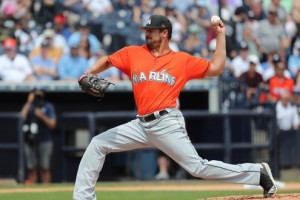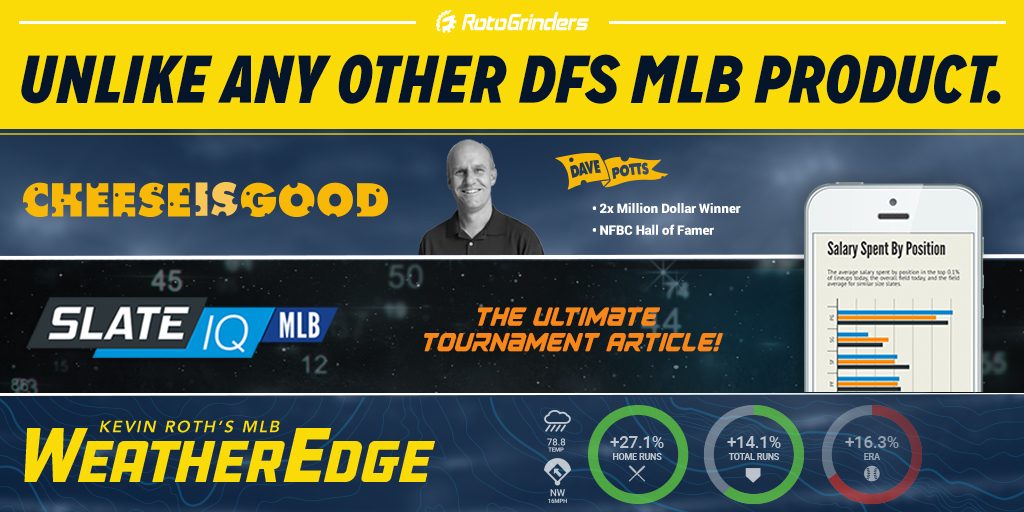10 Definitely Interesting, Possibly Helpful MLB Notes for Sunday, May 26th
Welcome to 10 Definitely Interesting, Possibly Helpful Notes! In this column, I’ll work to uncover some interesting bits of information that might shed some light on players from that day’s slate of MLB games. This is not a picks column, nor is it a “fun facts” article – it’s something in between.
I hope you enjoy it, and I hope it helps you think about today’s MLB plays in a new way as you build your DFS lineups. Here are 10 Notes for Sunday, May 26th.
1. Chris Paddack gets to an 0-2 count against 41.5 percent of the batters he’s faced this year; that’s the best rate in MLB, and he’s in some elite company, with Justin Verlander, Max Scherzer, Charlie Morton, and Gerrit Cole rounding out the top five. Paddack’s ability to command the strike zone is almost unfathomable for a pitcher in his debut, but he’s not purely a control artist; he can still miss plenty of bats, as his 28.7 percent strikeout rate attests. In fact, Paddack is one of only four qualified pitchers in MLB (joining Carlos Carrasco, Matt Boyd, and Max Scherzer to combine a 28 percent strikeout rate with a sub-6.0 percent walk rate. On Sunday, Paddack is in a winnable matchup against a Blue Jays team whose 25.3 percent strikeout rate and 75 wRC+ against right-handed pitching both rank in the bottom five in MLB this year. If money was no object, Paddack might be the top option on the slate. A certain game in Coors Field, however, may result in paying down a bit at pitcher for the optimal cash game build, which may lead to somebody like…
2. Zack Wheeler, who has allowed some runs in recent starts but is still pretty much the same pitcher as last year. Prior to the .125 BABIP in his last start, check out his BABIP marks for the five previous starts, with hard-hit rate in parentheses:
at WAS – .476 (40.9%)
vs. MIA – .450 (25.0%)
at MIL – .353 (35.3%)
vs. CIN – .350 (25.0%)
vs. PHI – .357 (21.4%)
For a pitcher as adept as Wheeler at limiting quality contact, five straight games of a .350+ BABIP is clearly an anomaly. To further illustrate how unlucky Wheeler has been this year, consider this: the 1.53-point gap between his ERA (4.74) and his FIP (3.68) represents the second-largest gap among qualifiers. Vegas agrees, as the Tigers are pegged with 3.35 implied run total, the lowest on the slate. While he may not possess the raw upside of someone like Justin Verlander (or even the pitcher we’ll discuss in note #3), Wheeler should have no trouble putting up a quality start with 6-8 strikeouts against a Tigers team that is completely helpless against right-handed pitching (26.1% K rate is third-highest in MLB; 72 wRC+ is second-lowest). He’s a cash game building block.

3. No qualified pitcher allows less contact in the strike zone than Caleb Smith (75.6%). That metric is usually a fairly reliable indicator of a pitcher’s dominance. Take a look at the MLB leaders for each of the past five seasons:
2018 – Max Scherzer (77.5%)
2017 – Chris Sale (79.2%)
2016 – Max Scherzer (79.0%)
2015 – Clayton Kershaw and Chris Sale (tied, 78.2%)
2014 – Chris Sale (80.5%)
If that’s not enough, how about this: his 16.6 percent swinging-strike rate is second-highest in MLB among qualifiers, trailing only Blake Snell. The wait-and-see period is over; Smith is the real deal. His matchup with the Nationals on Sunday won’t be a cakewalk: the Nationals’ 123 wRC+ against left-handed pitching is fourth-best in MLB. But for a pitcher with Sale-like, Snell-ian, Scherzer-esque strikeout upside, the matchup is essentially baked into his $9,700 tag at DraftKings. He’s an elite tournament play who may go a bit underowned if a.) people still don’t believe he’s this good, or b.) people are scared off by the matchup. Take advantage and roster MLB’s latest strikeout artist in GPPs.
4. Over his last five starts, Jake Odorizzi has an insane 0.89 ERA; that’s the second-best mark in MLB over that stretch behind only Hyun-Jin Ryu (0.71). Of course he’s not this good, and of course he’ll regress (the 5.1% HR/FB rate for a heavy fly ball pitcher looks especially fishy). But he should be able to stave off regression for one more start, as he’s in an elite matchup against the White Sox on Tuesday. As a team, the South Siders fan at a 26.7 percent clip against righties, the second-highest mark in the league (and it should rise with whiff-happy rookie Eloy Jimenez back in the lineup). Odorizzi costs just $8,200 at DraftKings, and he makes for an excellent SP2 option that should allow you to pay up for some of the big bats in high-offense environments (like, say, Coors Field against David Hess?).
5. Speaking of Hess, let’s hope that his friends and family like him, because Statcast sure doesn’t. Let’s look how the Orioles right-handed sometime starter ranks in a few noteable Statcast metrics. Of the 137 pitchers with at least 100 batted ball events, Hess ranks:
— 137th in average exit velocity (91.8 mph)
— 137th in average distance (228 feet)
— 137th in barrels per batted ball event (16.8)
— 135th in rate of hard-hit balls (49.0%)
— 133rd in xwOBA (.408)
There’s no need to belabor the point: play any Colorado player with a bat and a pulse. Because here’s the other thing: even if Hess (miraculously, impossibly, inconceivably) escapes without allowing much damage, the Orioles bullpen is allowing 1.99 HR/9, a mark that, if the season ended today, would represent the highest mark of all time.

6. Since 2017, no hitter in MLB has a higher ISO against right-handed sliders than Cody Bellinger (.373). Chris Archer throws his slider 33.7 percent of the time to lefties, and while it has been a successful pitch, Bellinger feasts on the pitch. Even on a less granular level, Bellinger has been unreal against right-handed pitching this year, slashing an impossible .421/.504/.825, with a 241 wRC+. This is a pure game theory play, as Bellinger’s ownership should be minuscule given his $5,700 tag at DraftKings. With Nolan Arenado and Trevor Story in the same price range, Bellinger should be an afterthought, especially given Archer’s name value.
7. Gary Sanchez has a .350 ISO against fly ball pitchers for his career; the only hitter with a better mark over that span (min. 200 PA) is J.D. Martinez (.353). Similarly to Bellinger, Sanchez represents a pivot off likely massive Coors ownership. He’s expensive, and nobody is going to want to pay up for a catcher in a seemingly tough matchup. Danny Duffy is not a bad pitcher by any stretch, but just as with Bellinger against Archer, I’ll side with the hitter here, making Sanchez an awesome contrarian play for GPPs.
8. Starlin Castro is a flawed player, but his hit tool has always been top notch. This year, he’s hitting a paltry .228, well off his career .279 average. Did Castro suddenly forget how to hit? What’s to blame for the sudden slide in batting average? The answer is about as rudimentary as it gets: BABIP. Let’s look at Castro’s year-to-year BABIP over the past five years, with his hard-hit rate in parentheses:
2016 – .305 (31.2%)
2017 – .347 (29.2%)
2018 – .330 (37.3%)
2019 – .244 (38.9%)
Despite making better contact than ever, the hits just haven’t fallen for Castro due to what seems to be simple bad luck. Because of his “struggles,” he’s priced all the way down to $2,700 at DraftKings in a good matchup against Nationals right-hander Erick Fedde (career .363 wOBA against right-handed hitters). Castro is not an exciting player to roster, and the upside is minimal, but this is the type of “he makes everything else work” play necessary for cash game construction.
9. Tanner Roark is allowing 30.1 percent line drives, an increase of 8.5 percentage points off his 2018 line drive rate of 21.7 percent; that’s the highest increase in MLB this year. Roark’s hard contact is also all the way up to 39.2 percent this year, after he had posted a hard-hit rate below 30 percent for every other season of his career dating back to 2013. He’s not the same pitcher in 2019, and I love the idea of getting low-owned tournament exposure to Cubs lefties.
10. Max Kepler has a .296 ISO and a low 13.9 percent strikeout rate against right-handed pitchers this year. That power/contact combination is rare, with only four other players matching those numbers against righties: Cody Bellinger, Alex Bregman, Tommy La Stella (!!!), and Anthony Rizzo. Kepler and the Twins find themselves in a hitting environment nearly as good as if they were playing at Coors Field, as they’ll take on the how-in-the-world-is-this-guy-a-starter-in-MLB offerings of Dylan Covey. Covey has a career .355 wOBA allowed to lefties, and at FanDuel specifically where he’s a reasonable $3,800, Kepler is a good way to get exposure to what should be a high-scoring offense.
_______________________________________________________________________________________________________
Thanks for reading! Stats from this article were pulled from RotoGrinders’ PlateIQ tool, FanGraphs, Baseball Prospectus, Baseball Savant, Brooks Baseball, and Baseball Reference.
Check back for more “10 Notes” MLB articles every Tuesday and Friday throughout the year, and feel free to leave a question or comment down below!
